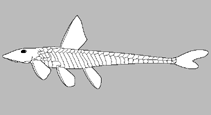Hypoptopoma elongatum Aquino & Schaefer, 2010
Upload your photos and videos
Google imageNo image available for this species;
drawing shows typical species in Loricariidae.
Google imageNo image available for this species;
drawing shows typical species in Loricariidae.
Classification / Names Common names | Synonyms | Catalog of Fishes(genus, species) | ITIS | CoL | WoRMS | Cloffa
Teleostei (teleosts) > Siluriformes (Catfishes) > Loricariidae (Armored catfishes) > Hypoptopomatinae
Etymology: Hypoptopoma: Greek, hypo = under + Greek, optoma, opsomai = to look at, to watch + Greek, poma = cover, operculum (Ref. 45335); elongatum: Named for the elongated general shape of the body, particularly marked at the tip of snout, caudal peduncle, and caudal fin.
Etymology: Hypoptopoma: Greek, hypo = under + Greek, optoma, opsomai = to look at, to watch + Greek, poma = cover, operculum (Ref. 45335); elongatum: Named for the elongated general shape of the body, particularly marked at the tip of snout, caudal peduncle, and caudal fin.
Environment: milieu / climate zone / depth range / distribution range Ecology
Freshwater; benthopelagic. Tropical
Distribution Countries | FAO areas | Ecosystems | Occurrences | Point map | Introductions | Faunafri
South America: Lower Rio Tapajos and lower Rio Trombetas.
Size / Weight / Age
Short description Identification keys | Morphology | Morphometrics
Vertebrae: 27. This species is distinguished from its congeners by having a non-pigmented band on the head positioned parallel to the ventral margin of the rostral and lateral snout plates and with the margin between pigmented and non-pigmented plates very well defined (vs. absence of a distinct pigmented. It can be further distinguished from its congeners, except for H. inexspectatum, by having the ventral surface of the anterior rostral plate as wide as the ventral surface of the first lateral rostral plates (vs. ventral surface gradually widening from anterior rostral to lateral rostral plates). It is readily distinguished from H. inexspectatum by having a greater number of plates along the trunk medial series 23 (vs. 20-21 (21)), by having the snout appearing pointed in dorsal view due to a slight concavity between rostral plate and first infraorbital (vs. snout typically spatulate), and by having, if present, a distinct series of odontodes along dorsal and ventral rostral margin of snout restricted to the anterior rostral plate (vs. series of odontodes along dorsal and ventral rostral margin of snout extended laterally to include second and third infraorbitals) (Ref. 84367).
Facultative air-breathing in the genus (Ref. 126274)
Life cycle and mating behavior Maturity | Reproduction | Spawning | Eggs | Fecundity | Larvae
Main reference
Upload your references | References | Coordinator : Fisch-Muller, Sonia | Collaborators
Aquino, A.E. and S.A. Schaefer, 2010. Systematics of the genus Hypoptopoma Günther, 1868 (Siluriformes, Loricariidae). Bull. Amer. Mus. Nat. Hist. 336:1-110. (Ref. 84367)
IUCN Red List Status (Ref. 130435: Version 2024-2)
Least Concern (LC) ; Date assessed: 07 November 2018
CITES
Not Evaluated
Threat to humans
Harmless
Human uses
FAO - Publication: search | FishSource |
More information
Trophic ecology
Food items
Diet composition
Food consumption
Food rations
Predators
Food items
Diet composition
Food consumption
Food rations
Predators
Ecology
Ecology
Ecology
Population dynamics
Growth parameters
Max. ages / sizes
Length-weight rel.
Length-length rel.
Length-frequencies
Mass conversion
Recruitment
Abundance
Growth parameters
Max. ages / sizes
Length-weight rel.
Length-length rel.
Length-frequencies
Mass conversion
Recruitment
Abundance
Life cycle
Reproduction
Maturity
Maturity/Gills rel.
Fecundity
Spawning
Spawning aggregations
Eggs
Egg development
Larvae
Larval dynamics
Reproduction
Maturity
Maturity/Gills rel.
Fecundity
Spawning
Spawning aggregations
Eggs
Egg development
Larvae
Larval dynamics
Anatomy
Gill area
Brain
Otolith
Gill area
Brain
Otolith
Physiology
Body composition
Nutrients
Oxygen consumption
Swimming type
Swimming speed
Visual pigments
Fish sound
Diseases & Parasites
Toxicity (LC50s)
Body composition
Nutrients
Oxygen consumption
Swimming type
Swimming speed
Visual pigments
Fish sound
Diseases & Parasites
Toxicity (LC50s)
Genetics
Genetics
Heterozygosity
Heritability
Genetics
Heterozygosity
Heritability
Human related
Aquaculture systems
Aquaculture profiles
Strains
Ciguatera cases
Stamps, coins, misc.
Aquaculture systems
Aquaculture profiles
Strains
Ciguatera cases
Stamps, coins, misc.
Tools
E-book | Field guide | Length-frequency wizard | Life-history tool | Point map | Classification Tree
| Catch-MSY |
Special reports
Download XML
Internet sources
AFORO (otoliths) | Aquatic Commons | BHL | Cloffa | BOLDSystems | Websites from users | Check FishWatcher | CISTI | Catalog of Fishes: genus, species | DiscoverLife | ECOTOX | FAO - Publication: search | Faunafri | Fishipedia | Fishtrace | GenBank: genome, nucleotide | GloBI | Google Books | Google Scholar | Google | IGFA World Record | MitoFish | Otolith Atlas of Taiwan Fishes | PubMed | Reef Life Survey | Socotra Atlas | Tree of Life | Wikipedia: Go, Search | World Records Freshwater Fishing | Zoobank | Zoological Record
Estimates based on models
Phylogenetic diversity index (Ref. 82804): PD50 = 0.5001 [Uniqueness, from 0.5 = low to 2.0 = high].
Bayesian length-weight: a=0.00851 (0.00374 - 0.01935), b=3.09 (2.90 - 3.28), in cm total length, based on LWR estimates for this (Sub)family-body shape (Ref. 93245).
Resilience (Ref. 120179): High, minimum population doubling time less than 15 months (Preliminary K or Fecundity.).
Fishing Vulnerability (Ref. 59153): Low vulnerability (10 of 100).




